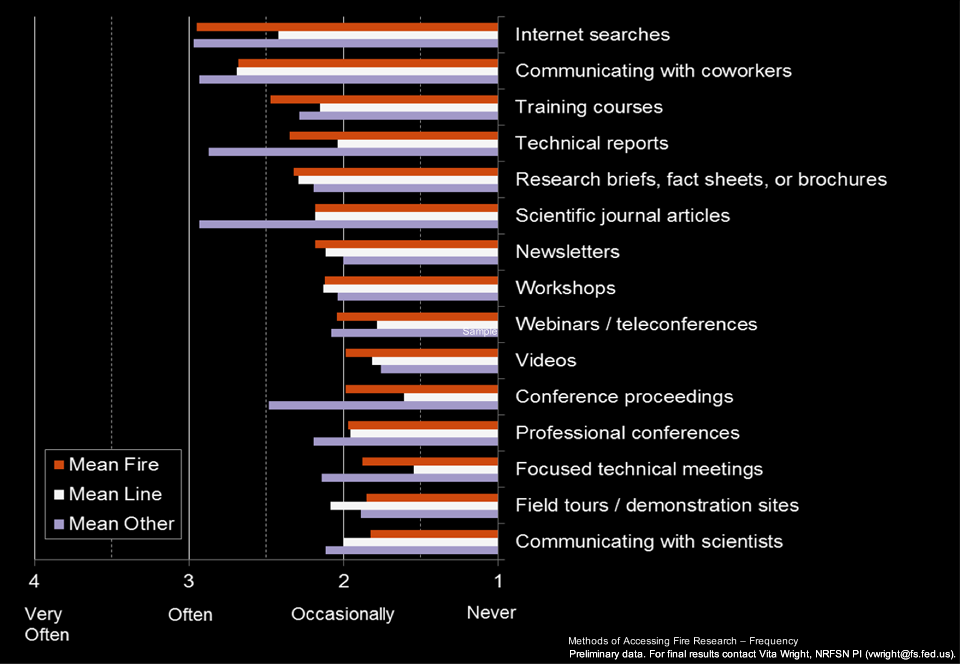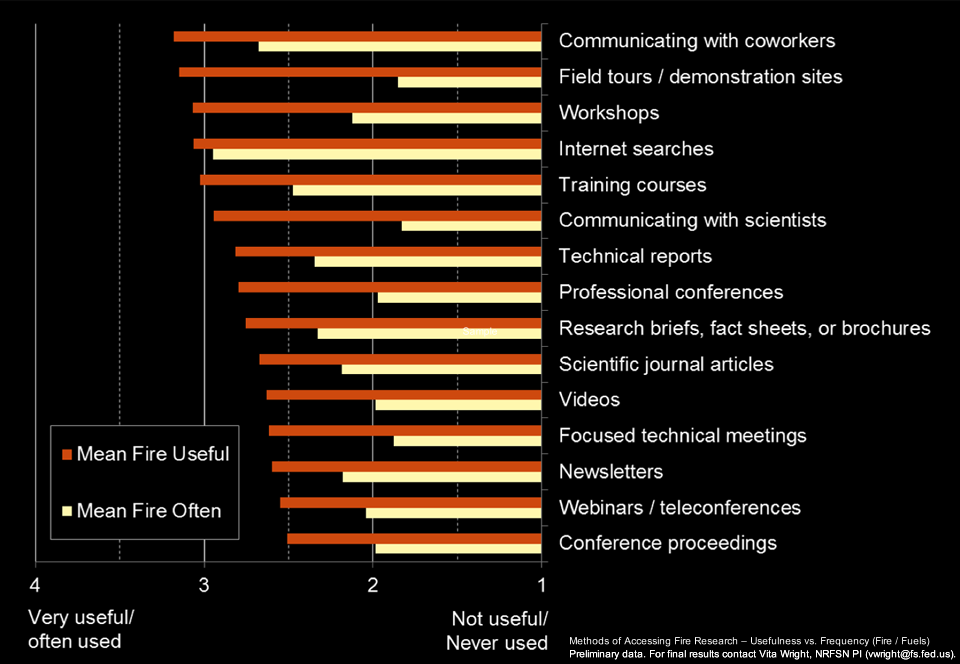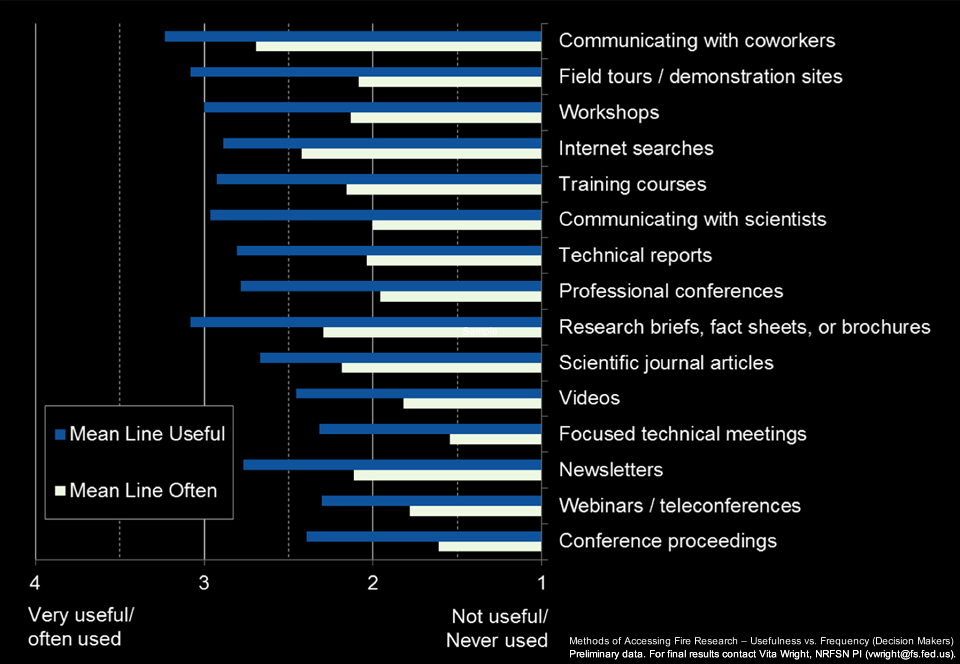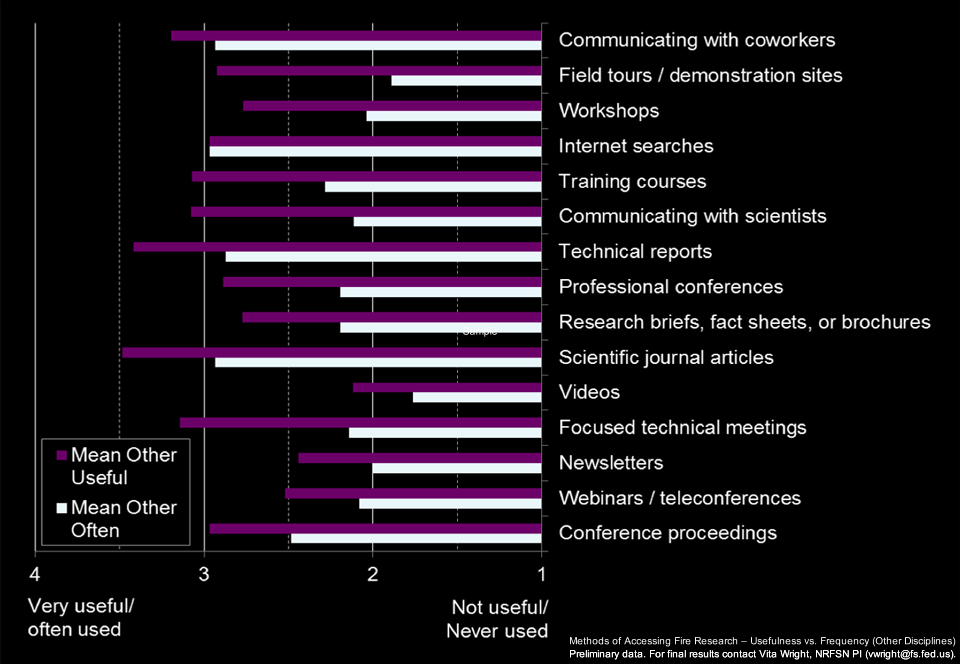In Spring 2011, the Northern Rockies Fire Science Network (NRFSN) conducted a Needs Assessment and asked managers the frequency and usefulness of various methods for accessing research.
Survey respondents were given a list of 15 potential methods for accessing fire research. They were asked to indicate 1) "how often you use each method to access fire research," and 2) "how useful the method is for accessing fire research." The first graph on this page compares the most frequently used methods by all three groups of respondents (Fire/Fuels Managers, Decision Makers, and Other Disciplinary Specialists). The next set of graphs shows the results for the "most useful" versus the "most frequently used" methods for each of the three groups.
Summary
Communication with coworkers and Internet searches were most frequently used to access fire research. The most useful methods were communication with coworkers, field tours/demonstration sites, and research briefs/fact sheets/brochures. Notably, field tours/demonstration sites, workshops, and communication with scientists were used less frequently than might be expected based on their usefulness. Tribal survey results regarding methods of access were consistent with these, as tribal land managers indicated the most useful methods for accessing research were field tours/demonstration sites, workshops, communicating with coworkers, Internet searches, and research briefs/fact sheets/brochures.
Most Frequently Used Methods
Comparison by Group (Figure 1)
Fire/Fuels Specialists (orange) and Other Disciplinary Specialists (purple) indicated they most frequently used Internet searches and communication with coworkers to access fire research. Next, Fire/Fuels Specialists used training courses, technical reports, and research briefs/fact sheets/brochures more frequently than other methods. This compares with other disciplinary specialists (natural resource managers and silviculturists), who used technical reports, scientific journal articles, and conference proceedings. Decision Makers (white) relied most on communication with coworkers, and then Internet searches, research briefs/fact sheets/brochures, scientific journal articles, training courses, workshops, newsletters, and field tours/demonstration sites to access fire research.
The tribal land manager survey had similar results (not shown). They most frequently used communication with coworkers, Internet searches, and research briefs/fact sheets/brochures.
In summary, all respondents used communication with coworkers (i.e., social networks) and Internet searches most frequently. After that, Fire/Fuels Specialists and Decision Makers relied on training courses and research briefs/fact sheets/brochures, whereas Other Disciplinary Specialists relied directly on technical reports and publications.
Most Useful vs. Most Frequently Used Methods
Fire / Fuels Specialists (Figure 2)
Fire and fuels specialists indicated the most useful methods for accessing research were communicating with coworkers (i.e., social networks), field tours/demonstration sites, workshops, Internet searches, and training courses. Whereas they frequently used some of these methods (Internet searches, communicating with coworkers, training courses), other methods were deemed useful but used much less frequently (field tours/demonstration sites and workshops).
Decision Makers (Figure 3)
Line and staff officers indicated the most useful methods for accessing research were communicating with coworkers (i.e., social networks), field tours/demonstration sites, research briefs/fact sheets/brochures, workshops, and communicating with scientists. Similar to fire/fuels specialists, they frequently used some of the most useful methods (communicating with coworkers and research briefs/fact sheets/brochures) and they used other methods that were deemed useful less frequently (field tours/demonstration sites, workshops, and communicating with scientists).
Other Disciplinary Specialists (Figure 4)
Natural resource managers and silviculturists indicated the most useful methods for accessing research were scientific journal articles, technical reports, communicating with coworkers (i.e., social networks), focused technical meetings, and communicating with scientists. They frequently used some of the most useful methods (communication with coworkers, tehnical reports, and scientific journal articles), as well as Internet searches. However, they used focused technical meetings, communication with scientists, workshops, and field tours/demonstration sites less frequently than would be expected based on their usefulness.



